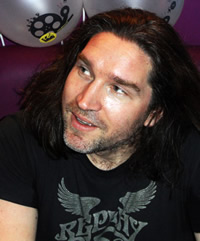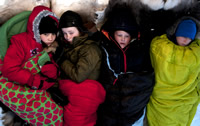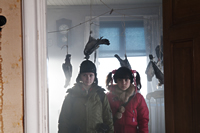“The film industry is so scared”
 Long ago at the BUFF Financing Forum Martin Högdahl pitched his project, two things stuck to my mind: children’s film and heavy metal. A rare combination. But ICE DRAGON is much more than that: problems with his alcoholic dad make Mik flee to his aunt’s little village. Here he makes friends, learns how to fish, builds a snow-scooter and finds peace of mind. Until one day there is a knock on the door… And Mik again is on the run.
Long ago at the BUFF Financing Forum Martin Högdahl pitched his project, two things stuck to my mind: children’s film and heavy metal. A rare combination. But ICE DRAGON is much more than that: problems with his alcoholic dad make Mik flee to his aunt’s little village. Here he makes friends, learns how to fish, builds a snow-scooter and finds peace of mind. Until one day there is a knock on the door… And Mik again is on the run.
Martin Högdahl: “I think ICE DRAGON fits very well in the Nordic storytelling tradition. It’s a very Astrid Lindgren-like story.”
Excuse me, but Astrid Lindgren wasn’t exactly the first name popping up in my mind when watching your film…
Högdahl: “I see a lot of similarities, for instance in the build-up of the story. Many Astrid Lindgren stories are about a child, often with a working class background, living on their own in the suburbs. From there the child sets off on an adventure in a very different, rural or fairy-tale like environment. You can clearly see how much the author Mikael Engstrom and me were influenced by her.”
 The story takes us from one end of the country to the other. Could you more or less point out the film geographically on the map of Sweden?
The story takes us from one end of the country to the other. Could you more or less point out the film geographically on the map of Sweden?
Högdahl: “We start in Stockholm. Then we go far north to a little village. These are the two different worlds I played around with. Stockholm is dark and grey and claustrophobic, like a nightmare. In the little village the scenery is all white and we pushed up the colours a bit. The soundtrack is important for the distinction between these two worlds: heavy metal in Stockholm, but upon his arrival in the village, that’s when we bring in the hip hop music. The atmosphere changes again when he sets off into the wild. The scale of the landscape becomes bigger and the images open up. The intermezzo in the foster family, again in a very different style, has a greener colour pallet. Like Indiana Jones or James Bond in one film travelling to many locations, each one with a very different atmosphere.”
The city scenes are pretty grim.
Högdahl: “Because Mik will not return to the city. In the first 10 minutes I had to show why he will not go back there; we even don’t want him to go back. Those scenes are a bit harsh, but we needed that. The contrast between darkness and light explains why he’s fighting so hard for his new home.”
This artistic choice somehow influenced the film’s target age: there’s lots of ‘motherfuckers’, zombie shooting, a horror scene…
Högdahl: “Yes, a scene from an old Swedish splatter movie. We asked the director if we could use it. We’ve discussed all this thoroughly. But for a 10 – 12 year old audience, most films are either too childish or too mature. I very much like that particular age when kids still have all the imagination and all those qualities that they’ll lose when growing onto their puberty. People are so scared of everything, especially the film industry. Children are not stupid, these days they are very well aware of their lives and their surroundings. That’s why I brought in these modern elements: zombies, hip hop, heavy metal… It was my task to keep the language and references contemporary, as the story takes place here and now.”
 Also the music strongly defines the atmosphere of the film.
Also the music strongly defines the atmosphere of the film.
Högdahl: “Hip hop and heavy metal are working class music, coming from people with a need to speak out. Heavy metal emerged from the blues, which was invented by slaves to endure the horrors they were living through. And all good hip hop comes from people struggling. For me heavy metal is a symbol of strength. I grew up in circumstances that were a bit similar to Mik and when I felt alone there was always music to listen to and films to watch. Watching them over and over again on the VCR, the characters became like friends. I wished my film to be like that: you watch it and you don’t feel alone anymore and you realize that if you keep on fighting, one day things will take a better turn.”
Considering the circumstances Mik grew up in, he ended up a pretty balanced boy.
Högdahl: “Part of the film you might consider autobiographical. Mik is a survivor, and so were my brother and I. There are different ways of going through these emotions. My way was very much inwards, while my brother was very much outwards.”
And which one ended up in jail?
Högdahl: “Well, my brother should, but didn’t!”
Mik doesn’t get much help from the social services. You portray them as immoral and incompetent.
Högdahl: “They’re not bad people. They’re working according to the country’s laws and regulations: “We’re not the ones making the laws, we just do as we’re told”. It’s probably one of the toughest jobs in the world. Even Mik’s father in the book wasn’t such a nice person. In the film it is important that we somehow like him. We have to understand he is not a bad man, but a man with a problem. Like the foster family, who are basically very unhappy people. In those scenes I very much followed the way the characters were depicted in the book, adding just one little anecdote from my own family.”
Which one?
Högdahl: “As children one day my uncle and my father had an argument over breakfast. My uncle grabbed a spoon and hit my father hard on the head. That really hurts!”
How did you work with the dogs in the foster family?
Högdahl: “Filming in winter in the north of Sweden with children and animals was definitely not a good idea for a debuting filmmaker. I was happy to have a crew who knew how to work with dogs, cats…”
Not to mention the whale!
Högdahl: “Well… The CGI team took care of him. We don’t have whales at the Swedish coast. Even the whale in the museum in the beginning of the film, was one that got lost and stranded in Sweden.”
What is their role in the story?
Högdahl: “Falling into the water and drowning, from below comes a whale that pushes up Mik. That’s how it should be: when someone falls, somebody should come up to lift him up. The whale is a symbol of the movie’s theme: finding your way home, as well physically as in your heart. Whales are singing to each other over long distances. If one gets lost, the others go to find him. It’s the sound of their singing that leads them home.”
I never thought a whale would summarise the story so well…
Högdahl: “It is a story about the meaning of family and friendship. When the adults can no longer protect Mik, the children say: we’ll do it! When setting out together into the wild, they take charge. Why? Because they’re fighting for justice, they’re doing the right thing. The whole society in the little village takes its responsibility and comes up for Mik when he’s in need.”
Who is Pi, the little girl he meets?
Högdahl: “I wanted her to be half Swedish, half Thai, because of the Thai community in the north of Sweden.”
A Thai community in the north of Sweden?
Högdahl: “Well… There are a lot of lonely men up there… In the book she was a corky Swedish girl, but I made her like a manga character. The actress Feline Andersson was fantastic. She’s a star. She acts, writes songs, plays the guitar, she can sing and dance, she can do anything. She’s going to be huge.”
How about the circumstances of the shooting?
Högdahl : “The shooting took 40 days. Particularly the scenes in the north were tough to shoot as it was –35°. But, honestly… Quite a bit of the ice was digitalized.”
What about your future plans?
Högdahl: “I’m working on a story about the circumstances in which I grew up, living in a working class neighbourhood in Gothenburg with my mum and brother. In the early nineties the crisis hit Sweden really hard, not only financially but also on the moral level. Suddenly the world became a dark place. Our Prime Minister, Olof Palme, got murdered, the right wing party got into the parliament and in post offices people were waiting for their pay check. You know… The whole of Sweden is one big forest with nothing but trees. Living in concrete houses in the suburbs at the far edge of town, that’s where the forest began. We spent all our time there as none of us wanted to go home. A kind of LET THE RIGHT ONE IN-like environment. But it’s not going to be a dark film. I make films to give people hope. Look at me: all the darkness that I’ve been through turned into a treasure that now gives me strength.”
Gert Hermans
